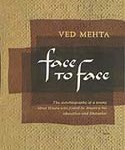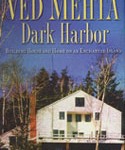At Home with Ved Mehta: In a Dark Harbor, a Bright House
ISLESBORO, Me. — The snow was knee-deep on the day Ved Mehta and the architect Edward Larrabee Barnes walked through an uncleared forest here, discussing the view of Penobscot Bay. It was December 1982, and the plutocrats who occupy the island’s enormous Georgian-style mansions during the summer were gone. Finding a stretch of level ground, Mr. Barnes paced the outline for a house and said to Mr. Mehta, “I think once you’ve got your house here and done the initial cutting, Ved, you’d have to live here and experiment to see which trees got in the way of your view, and which trees you fell in love with and wanted to protect and keep.”
The advice, common sense really, was at the time highly hypothetical. In the first place, Mr. Mehta did not have money to build a house on the property, however appealing the sightlines. And in the second, Mr. Mehta is blind.
Twenty-one years later, Mr. Mehta, 69, has not only a house, but, as with many of his endeavors over the last 46 years, a book to show for it as well. A former contributor to The New Yorker, Mr. Mehta has written extensively, and exhaustively, about his life in India and New York and at Oxford. “Dark Harbor: Building House and Home on an Enchanted Island,” his 10th autobiographical book, published by Thunder’s Mouth Press, follows his adventures in the world of contractors, landscapers, fix-its and architects.
 DESIGN FOR THE SENSES: The architect Edward Larrabee Barnes designed a living space and a stairwell that channel air and light. DESIGN FOR THE SENSES: The architect Edward Larrabee Barnes designed a living space and a stairwell that channel air and light. |
On a brisk sunny Saturday in May, Mr. Mehta sat with his wife, Linn Cary Mehta, on a white mahogany deck chair, facing the same waters that he had faced with Mr. Barnes, and in the manner of summer-house owners everywhere, he griped about the hardship. “Imagine taking care of this bloody place from New York,” he said. “With all the time I’ve taken, I could have written two books.”
The book he wrote instead, named for the southern part of the island, is the story of a blind man grappling with the idea of visual perfection. Mr. Barnes, who knew Mr. Mehta’s writing, is highly regarded for his modernist geometric designs for the I.B.M. Building on 57th Street in Manhattan and the Walker Art Center in Minneapolis.
Islesboro is a 14-mile sliver of island scalloped with rocky bays and coves, accessible by a short ferry ride from Lincolnville, Me., about four hours northeast of Boston.
Though Mr. Mehta lost his sight from spinal meningitis at the age of 4, he said he had a residual memory of vision. In New York he walks familiar streets and takes buses without a cane or a dog. When it came to designing his own house, something he had never imagined before, he said he wanted no special allowances for his blindness.
“Because I grew up with six sighted brothers and sisters, I never thought the world should adapt to me,” he said. “I thought I should adapt to the world. I wanted a house that my six siblings would appreciate.”

“The house is built for the eye, not the ear,” Mr. Mehta said, referring to its tendency to channel sound as well. Photos: David Murray Jr. for The New York Times |
With that in mind, he said, he thought of the house during the design stage more as Mr. Barnes’s baby than his own. His role, as he described it, was to listen patiently to each of the architect’s inspirations and say something along the lines of “But isn’t that going to cost an awful lot of money?”
Mr. Mehta, who had to imagine architectural drawings and intended effects, said he had immersed himself more in the nature of the creative process. Unlike writers, he realized, architects can be at the mercy of their clients. For Mr. Mehta, a protégé of the famously subtle New Yorker editor William Shawn, whose departure from the magazine in 1987 precipitated Mr. Mehta’s own, this gave clients too much say.
“I let Ed decide everything,” he said. “I never had demands because I never liked demands from an editor. With Mr. Shawn, the whole thing was to lead the writer to the story. Good work comes from the editor being a midwife, not an impregnator.”
Mr. Mehta said his one request was a quiet house, because he gleans all his spatial cues from sound. What he got was a lesson in the acoustic properties of modern building materials like wallboard and glass, which transmit or reflect sound.
The house that Mr. Barnes designed is clean and angular, with sliding glass doors framed in mahogany that let in floods of light and, to Mr. Mehta’s dismay, bounce sound harshly around the boxy rooms. The house has an open staircase that similarly carries sound from the basement to the third floor.
“The house is built for the eye, not the ear,” Mr. Mehta said. “Everything in the house was done visually. Modern architects are interested in light and air.” They don’t care about sound, he said.
Speaking by telephone, Mr. Barnes, 88, described Mr. Mehta as an attentive client and a character. “When we were on the land,” he said, “he’d follow right behind me and ask me what I saw,” adding that the challenge of describing blueprints or ideas to a blind client “was part of the fun of the thing.”
At first, Mr. Barnes had considered keeping the house on one level to accommodate Mr. Mehta’s blindness, but the writer rejected the idea. “He was very strong about that,” Mr. Barnes said. “Neither of us wanted it to sprawl over the land.”
An addition Mr. Barnes designed, completed in 1994, relieves the symmetry of the house and, to everyone’s surprise, made all of the rooms quieter. Mr. Mehta has filled the home mostly with modern paintings, including two by the Indian artist Krishan Khanna. Toshiko Mori, who is now chairwoman of the architecture department at the Harvard Graduate School of Design, helped select furnishings, including stark sisal mats.
As a literary genre, the house-building (or house-renovating) memoir proceeds toward happiness through a long series of unhappy accidents, and usually involves the kind of masculine spiritual growth that once required the presence of an athletic coach. Peter Mayle, perhaps the most engaging of the literary renovators, made sport with the caprices of his French contractors and artisans, seizing in their delays the time to write “A Year in Provence” and “Toujours Provence.”
Mr. Mehta’s book, by contrast, reflects the craggy severity of the Maine island, where the waters are near freezing and the old-money social set can be not so warm. By his own description an Oxford curmudgeon, with tastes running to “heavy, sombre” architecture, Mr. Mehta brought stiff expectations to the similarly crusty craftsmen of New England. The flat r’s of their speech grate against his ear, and for all his talk of adaptation, he never lets readers forget this.
But for Mr. Mehta, as for other practitioners of the genre, the house also serves as a metaphor for his own development: the foundation, the unforeseen difficulties, the extemporaneous and unbudgeted solutions and so on. (He smiled politely at a suggestion that without this metaphor, the makers of expensive window treatments or plumbing fixtures would have no glossy shelter magazines in which to sell their wares.)
Shortly before he started building the house, Mr. Mehta also began dating Linn Cary, the niece of a colleague at The New Yorker, the science writer Henry S. F. Cooper Jr. They married in 1983. Ms. Cary is the great-great-great granddaughter of James Fenimore Cooper, and one more generation removed from William Cooper, the land speculator and United States congressman for whom Cooperstown, N.Y., was named. They have two teenage daughters who grew up spending summers in Dark Harbor.
When they started dating, Mr. Mehta was nearly 50 and never married. Ms. Cary is 21 years his junior. “The land showed me that Ved knew what he wanted,” she said. “This gave us a place to build on.” As the marriage evolved, she said, the house “became a place we created for our children.”
Mr. Mehta reflected on the journey. “I move crabwise,” he said. “Most people find a wife, then build a house. I bought land without having a wife or knowing how I’d get here.”
As the afternoon shadows brought a chill to the house, Mr. Mehta winced at the sound of the heating system rumbling up from the basement. Such is the process of accommodation, he said.
“Really, I wanted to buy an old house and adapt to it,” he said. “In America, everyone thinks he can build his own dream house. In the rest of the world, you adapt to the house. This country is so rich, everyone wants to dominate the world, not adapt to it.
“Twenty years after I built the house, I’m still adapting to it. It’s not a dream house.”





